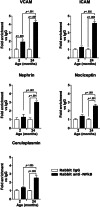Aging in the glomerulus
- PMID: 22843670
- PMCID: PMC3636672
- DOI: 10.1093/gerona/gls157
Aging in the glomerulus
Abstract
Kidney function declines with age in the majority of the population. Although very few older people progress to end stage, the consequences of doing so are burdensome for the patient and very expensive for the society. Although some of the observed decline is likely due to changes in the vasculature, much is associated with the development of age-associated glomerulosclerosis. This article will review the well-established structural and functional changes in the glomerulus with age. The role of calorie restriction in modifying age-related pathology will be discussed. The importance of the podocyte as a critical cell in the aging process is considered using animal models and human biopsy material. Newer data on changes in gene expression driven by nuclear factor kappa beta (NFkB) and possible changes in biology in the glomerulus are discussed. The relationship between pathways involved in aging and the decline in kidney function is reviewed. There is speculation on the significance of these changes in relation to normal and pathological aging.
Figures



Similar articles
-
Podocytes and glomerular function with aging.Semin Nephrol. 2009 Nov;29(6):587-93. doi: 10.1016/j.semnephrol.2009.07.012. Semin Nephrol. 2009. PMID: 20006790 Free PMC article. Review.
-
Podocyte hypertrophy, "adaptation," and "decompensation" associated with glomerular enlargement and glomerulosclerosis in the aging rat: prevention by calorie restriction.J Am Soc Nephrol. 2005 Oct;16(10):2953-66. doi: 10.1681/ASN.2005050488. Epub 2005 Aug 24. J Am Soc Nephrol. 2005. PMID: 16120818
-
FYVE domain-containing protein ZFYVE28 regulates EGFR-signaling in podocytes but is not critical for the function of filtration barrier in mice.Sci Rep. 2018 Mar 16;8(1):4712. doi: 10.1038/s41598-018-23104-z. Sci Rep. 2018. PMID: 29549365 Free PMC article.
-
Beta1 integrin expression by podocytes is required to maintain glomerular structural integrity.Dev Biol. 2008 Apr 15;316(2):288-301. doi: 10.1016/j.ydbio.2008.01.022. Epub 2008 Jan 31. Dev Biol. 2008. PMID: 18328474 Free PMC article.
-
Targeting podocyte-associated diseases.Adv Drug Deliv Rev. 2010 Nov 30;62(14):1325-36. doi: 10.1016/j.addr.2010.08.012. Epub 2010 Sep 7. Adv Drug Deliv Rev. 2010. PMID: 20828590 Review.
Cited by
-
Connectivity mapping of glomerular proteins identifies dimethylaminoparthenolide as a new inhibitor of diabetic kidney disease.Sci Rep. 2020 Sep 10;10(1):14898. doi: 10.1038/s41598-020-71950-7. Sci Rep. 2020. PMID: 32913274 Free PMC article.
-
Global glomerulosclerosis with nephrotic syndrome; the clinical importance of age adjustment.Kidney Int. 2018 May;93(5):1175-1182. doi: 10.1016/j.kint.2017.09.028. Epub 2017 Dec 19. Kidney Int. 2018. PMID: 29273332 Free PMC article.
-
Resveratrol Pretreatment Ameliorates Concanavalin A-Induced Advanced Renal Glomerulosclerosis in Aged Mice through Upregulation of Sirtuin 1-Mediated Klotho Expression.Int J Mol Sci. 2020 Sep 15;21(18):6766. doi: 10.3390/ijms21186766. Int J Mol Sci. 2020. PMID: 32942691 Free PMC article.
-
Cells of renin lineage take on a podocyte phenotype in aging nephropathy.Am J Physiol Renal Physiol. 2014 May 15;306(10):F1198-209. doi: 10.1152/ajprenal.00699.2013. Epub 2014 Mar 19. Am J Physiol Renal Physiol. 2014. PMID: 24647714 Free PMC article.
-
A roadmap for the genetic analysis of renal aging.Aging Cell. 2015 Oct;14(5):725-33. doi: 10.1111/acel.12378. Epub 2015 Jul 29. Aging Cell. 2015. PMID: 26219736 Free PMC article. Review.
References
-
- U.S. Renal Data System USRDS 2011 Annual Data Report: Atlas of End-Stage Renal Disease in the United States . Bethesda, MD: National Institutes of Health, National Institute of Diabetes and Digestive and Kidney Diseases; 2008.
-
- Jennette JC Olson JL Schwartz MM Silva FGeds. Heptinstall’s Pathology of the Kidney 6th ed Philadelphia, NY: Lippincott-Raven; 2006.
-
- Goyal VK. Changes with age in the human kidney. Exp Gerontol 1982;17:321 331 - PubMed
-
- Lindeman RD, Tobin J, Shock NW. Longitudinal studies on the rate of decline in renal function with age. J Am Geriatr Soc 1985;33:278 285 - PubMed
Publication types
MeSH terms
Substances
Grants and funding
LinkOut - more resources
Full Text Sources
Other Literature Sources
Medical

